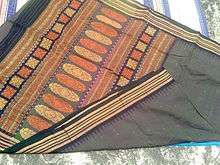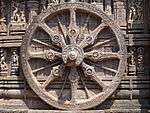Bomkai Sari
Bomkai Sari (also Sonepuri Sari) is a handloom saree from Odisha, India. It is an origin of Bomkai,and is primarily produced by the “Bhulia” in( menda )20°50'01.6"N 83°38'01.5"E Menda, Odisha 767016

https://goo.gl/maps/u8nTh4h3frMMVSmR8 community of Subarnapur district.[1] Bomkai is one of the identified Geographical Indications of India.[2] Sonepur handloom sarees, Sonepuri paatas and silk sarees are popular items displayed at various fashion shows.[3]
About
BOMKAI - Modern in Design with Traditional Tinge[4] Bomkai cotton sarees are mostly accepted for habitual wear and the silk sari is put on ceremonies and sacred occasions. Most of the stylish saree are embodied with captivating color to give the gracious look to the woman wearing the saree. The ancient belief is depicted in its border Mostly the design of fish is seen in the sari as it is believed to be a sign of success and affluence. The most charming part is its thread work in the designs of the border and the palloo. The appearance of the saree is related to simplicity and has a tribal tinge in it. The sari is normally dyed to attain the red, black and white background colours. However, today you will find the sari in several designs and multiple colours while retaining their originality. The warps are suitably woven to produce multicoloured end piece.
History

Bomkai sari was first originated in the village of Bomkai in Ganjam district of Odisha.[5] During the time of Ramai Dev the then ruler of Patna it was introduced in Sonepur.[1]
Trivia
Aishwarya Rai wore a kind of bomkai called "Radhakunja" during her wedding with Abhishek Bachchan.[6] Three saris were designed by Chaturbhuj Meher at Sonepur.[7]
References
- "Sarees of Orissa". Retrieved 27 January 2016.
- "STATE WISE REGISTRATION DETAILS OF G.I APPLICATIONS" (PDF). Ipindia.nic.in. Archived from the original (PDF) on 27 March 2016. Retrieved 28 January 2016.
- Hunt for handloom brand ambassador
- Odisha, Handloom. "BOMKAI - Modern in Design with Traditional Tinge". orisahandloom.com.
- Aditi Ranjan; M. P. Ranjan (2009). Handmade in India: A Geographic Encyclopedia of Indian Handicrafts. Abbeville Press. ISBN 978-0-7892-1047-0.
- "Ash-Abhi Wedding". Archived from the original on 2010-12-22. Retrieved 2010-11-09.
- "Orissa sari to drape Bachchan bahu - Mom-in-law Jaya zeroed in on trousseau in February". www.telegraphindia.com. The Telegraph. Retrieved 28 January 2016.
